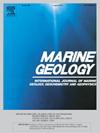潮汐动力调节的浮群大小不对称驱动人工潮汐通道中净向陆地输沙
IF 2.2
3区 地球科学
Q2 GEOSCIENCES, MULTIDISCIPLINARY
引用次数: 0
摘要
在自然水体系统中,絮凝作用通过改变颗粒大小和沉降速度来影响沉积物的运移。然而,潮汐周期中絮体大小的不对称性及其对沉积物输运的影响,特别是在受人类活动影响的浑浊沿海地区,仍未得到充分研究。本研究利用位于朝鲜半岛西海岸的人工潮汐通道内的ADV、HR-ADCP、Signature ADCP、LISST和CTD的综合观测资料,阐明了泥沙的大小依赖输运过程。我们的发现揭示了海底剪切速度和粒径分布(PSD)的潮汐不对称性。退潮时,底面剪切速度增大,悬沙浓度(SSC)、总积浓度(TVC)和平均粒径(Mz)均小于涨潮时;这表明,除再悬浮外,平流输送是涨潮期间颗粒物的重要来源。这些颗粒增加了SSC、TVC和向陆沙通量,而低剪切速度有利于絮凝,导致Mz升高。因此,微絮凝体和大絮凝体的比例更高,导致涨潮到高松弛水的沉降通量更高。低潮时平流输运减弱,SSC降低,向海输沙通量降低,剪切速度增强,浓度降低,絮凝作用弱,Mz降低。退潮时,絮凝体(直径10 ~ 20 μm)超过微絮凝体和大絮凝体,沉降通量较小。这种浮冰大小的潮汐不对称解释了在涨潮和高水位期间较大颗粒的捕获,最终导致潮汐循环期间河道中向陆地的净沉积物通量。本文章由计算机程序翻译,如有差异,请以英文原文为准。
Floc size asymmetry modulated by tidal dynamics drives net landward sediment transport in a man-made tidal channel
In natural aquatic systems, flocculation affects sediment transport by altering particle size and settling velocity. However, the asymmetry in floc size over tidal cycles and its influence on sediment transport, especially in turbid coastal regions affected by human activities, remains understudied. This study uses comprehensive observations from ADV, HR-ADCP, Signature ADCP, LISST, and CTD within a man-made tidal channel located on the west coast of the Korean Peninsula to elucidate the size-dependent sediment transport process. Our findings reveal a tidal asymmetry in bottom shear velocity and particle size distribution (PSD). During ebb tide, the bottom shear velocity was higher, but suspended sediment concentration (SSC), Total Volume Concentration (TVC), and mean size () were lower compared to flood tide. This suggests that advection transport, in addition to resuspension, is a significant source of particles during flood tide. These particles increased SSC, TVC, and landward sediment flux, while low shear velocity facilitated flocculation, resulting in higher . Consequently, a higher proportion of microflocs and macroflocs occurred, leading to a higher settling flux from flood tide to high slack water. In contrast, weaker advection transport and low SSC during ebb tide led to lower seaward sediment flux, with stronger shear velocity and lower concentration resulting in weak flocculation and lower . During ebb tide, flocculi (10–20 μm diameter) exceeded microflocs and macroflocs, causing a lesser settling flux. This tidal asymmetry in floc size explains the trapping of larger particles during flood tide and high water levels, ultimately leading to net landward sediment flux in the channel over tidal cycles.
求助全文
通过发布文献求助,成功后即可免费获取论文全文。
去求助
来源期刊

Marine Geology
地学-地球科学综合
CiteScore
6.10
自引率
6.90%
发文量
175
审稿时长
21.9 weeks
期刊介绍:
Marine Geology is the premier international journal on marine geological processes in the broadest sense. We seek papers that are comprehensive, interdisciplinary and synthetic that will be lasting contributions to the field. Although most papers are based on regional studies, they must demonstrate new findings of international significance. We accept papers on subjects as diverse as seafloor hydrothermal systems, beach dynamics, early diagenesis, microbiological studies in sediments, palaeoclimate studies and geophysical studies of the seabed. We encourage papers that address emerging new fields, for example the influence of anthropogenic processes on coastal/marine geology and coastal/marine geoarchaeology. We insist that the papers are concerned with the marine realm and that they deal with geology: with rocks, sediments, and physical and chemical processes affecting them. Papers should address scientific hypotheses: highly descriptive data compilations or papers that deal only with marine management and risk assessment should be submitted to other journals. Papers on laboratory or modelling studies must demonstrate direct relevance to marine processes or deposits. The primary criteria for acceptance of papers is that the science is of high quality, novel, significant, and of broad international interest.
 求助内容:
求助内容: 应助结果提醒方式:
应助结果提醒方式:


